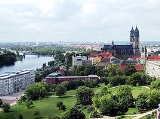
Cathedral of Magdeburg
Encyclopedia
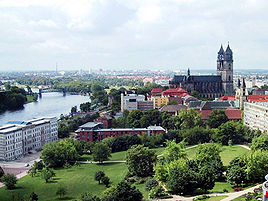
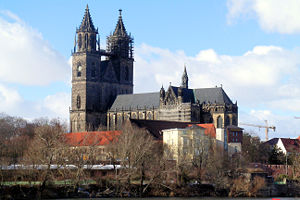
Evangelical Church in Germany
The Evangelical Church in Germany is a federation of 22 Lutheran, Unified and Reformed Protestant regional church bodies in Germany. The EKD is not a church in a theological understanding because of the denominational differences. However, the member churches share full pulpit and altar...
Cathedral of Magdeburg , officially called the Cathedral of Saints Catherine and Maurice , is the oldest Gothic
Gothic architecture
Gothic architecture is a style of architecture that flourished during the high and late medieval period. It evolved from Romanesque architecture and was succeeded by Renaissance architecture....
cathedral in Germany. It is the proto-cathedral of the former Prince-Archbishopric of Magdeburg
Archbishopric of Magdeburg
The Archbishopric of Magdeburg was a Roman Catholic archdiocese and Prince-Bishopric of the Holy Roman Empire centered on the city of Magdeburg on the Elbe River....
. Today it's the principal church of the Evangelical Church in Central Germany
Evangelical Church in Central Germany
The Evangelical Church in Central Germany is a United church body covering most of the German states of Saxony-Anhalt and Thuringia and some adjacent areas in Brandenburg and Saxony .- History :...
. One of its steeple
Steeple (architecture)
A steeple, in architecture, is a tall tower on a building, often topped by a spire. Steeples are very common on Christian churches and cathedrals and the use of the term generally connotes a religious structure...
s is 99.25 m (325 ft 7 in) tall, and the other is 100.98 m (331 ft 4 in), making it one of the tallest cathedrals in eastern Germany. The cathedral is likewise the landmark of Magdeburg
Magdeburg
Magdeburg , is the largest city and the capital city of the Bundesland of Saxony-Anhalt, Germany. Magdeburg is situated on the Elbe River and was one of the most important medieval cities of Europe....
, the capital city of the Bundesland
States of Germany
Germany is made up of sixteen which are partly sovereign constituent states of the Federal Republic of Germany. Land literally translates as "country", and constitutionally speaking, they are constituent countries...
of Saxony-Anhalt
Saxony-Anhalt
Saxony-Anhalt is a landlocked state of Germany. Its capital is Magdeburg and it is surrounded by the German states of Lower Saxony, Brandenburg, Saxony, and Thuringia.Saxony-Anhalt covers an area of...
, and is also home to the grave of Emperor Otto I the Great
Otto I, Holy Roman Emperor
Otto I the Great , son of Henry I the Fowler and Matilda of Ringelheim, was Duke of Saxony, King of Germany, King of Italy, and "the first of the Germans to be called the emperor of Italy" according to Arnulf of Milan...
.
The first church built in 937 at the location of the current cathedral was an abbey called St. Maurice, dedicated to Saint Maurice
Saint Maurice
Saint Maurice was the leader of the legendary Roman Theban Legion in the 3rd century, and one of the favorite and most widely venerated saints of that group. He was the patron saint of several professions, locales, and kingdoms...
. The current cathedral was constructed over the period of 300 years starting from 1209, and the completion of the steeples took place only in 1520. Despite being repeatedly looted, the Cathedral of Magdeburg is rich in art, ranging from antiques to modern art.
Previous building
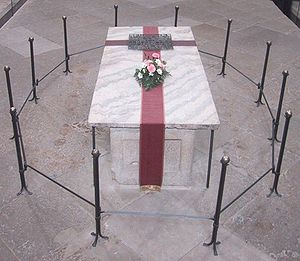
Abbey
An abbey is a Catholic monastery or convent, under the authority of an Abbot or an Abbess, who serves as the spiritual father or mother of the community.The term can also refer to an establishment which has long ceased to function as an abbey,...
called St. Maurice (St. Moritz), dedicated to Saint Maurice
Saint Maurice
Saint Maurice was the leader of the legendary Roman Theban Legion in the 3rd century, and one of the favorite and most widely venerated saints of that group. He was the patron saint of several professions, locales, and kingdoms...
and financed by Emperor Otto I the Great
Otto I, Holy Roman Emperor
Otto I the Great , son of Henry I the Fowler and Matilda of Ringelheim, was Duke of Saxony, King of Germany, King of Italy, and "the first of the Germans to be called the emperor of Italy" according to Arnulf of Milan...
. Otto wanted to demonstrate his political power after the successful Battle of Lechfeld
Battle of Lechfeld
The Battle of Lechfeld , often seen as the defining event for holding off the incursions of the Hungarians into Western Europe, was a decisive victory by Otto I the Great, King of the Germans, over the Hungarian leaders, the harka Bulcsú and the chieftains Lél and Súr...
in 955, and ordered the construction even before his coronation as Emperor on February 2, 962. Furthermore, to support his claim as successor of the Emperor of the Weströmisches Reich, he obtained a large number of antiques – for example, pillars to be used for the construction of the church. Many of those antiques were subsequently used for the second church in 1209. The church had most likely one nave
Nave
In Romanesque and Gothic Christian abbey, cathedral basilica and church architecture, the nave is the central approach to the high altar, the main body of the church. "Nave" was probably suggested by the keel shape of its vaulting...
with four aisles, a width of 41 meters and a length of 80 meters. The height is estimated as up to 60 meters.
The wife of Otto, Queen Eadgyth
Eadgyth
Edith of England , also spelt Eadgyth or Ædgyth, was the daughter of Edward the Elder, and the wife of Otto I, Holy Roman Emperor.-Life:...
, was buried in the church after her death in 946. The church was expanded in 955. Hence, the church became a cathedral
Cathedral
A cathedral is a Christian church that contains the seat of a bishop...
. In 968, Emperor Otto I selected Magdeburg
Magdeburg
Magdeburg , is the largest city and the capital city of the Bundesland of Saxony-Anhalt, Germany. Magdeburg is situated on the Elbe River and was one of the most important medieval cities of Europe....
as the seat of an archdiocese
Diocese
A diocese is the district or see under the supervision of a bishop. It is divided into parishes.An archdiocese is more significant than a diocese. An archdiocese is presided over by an archbishop whose see may have or had importance due to size or historical significance...
with Adalbert von Trier as archbishop, even though the city was not centrally located but at the eastern border of his kingdom. He did this because he planned to expand his kingdom, and also Christianity, to the east into what is nowadays Poland
Poland
Poland , officially the Republic of Poland , is a country in Central Europe bordered by Germany to the west; the Czech Republic and Slovakia to the south; Ukraine, Belarus and Lithuania to the east; and the Baltic Sea and Kaliningrad Oblast, a Russian exclave, to the north...
. This plan, however, failed. Emperor Otto I died soon thereafter in 973 in Memleben
Memleben
Memleben is a village and a former municipality in the Burgenlandkreis district, in Saxony-Anhalt, Germany. Since 1 July 2009, it is part of the municipality Kaiserpfalz...
and was also buried in the cathedral next to his wife.
The entire cathedral St. Maurice was destroyed on Good Friday
Good Friday
Good Friday , is a religious holiday observed primarily by Christians commemorating the crucifixion of Jesus Christ and his death at Calvary. The holiday is observed during Holy Week as part of the Paschal Triduum on the Friday preceding Easter Sunday, and may coincide with the Jewish observance of...
in 1207 by a city fire. All but the southern wing of the cloister
Cloister
A cloister is a rectangular open space surrounded by covered walks or open galleries, with open arcades on the inner side, running along the walls of buildings and forming a quadrangle or garth...
burned down. Archbishop Albrecht II von Kefernburg decided to pull down the remaining walls and construct a completely new cathedral, against some opposition of the people in Magdeburg. Only the south wall of the cloister is still standing. The exact location of the old church remained unknown for a long time, but the foundations were rediscovered in May 2003, revealing a building 80 m long and 41 m wide. The old crypt
Crypt
In architecture, a crypt is a stone chamber or vault beneath the floor of a burial vault possibly containing sarcophagi, coffins or relics....
has been excavated and can be visited by the public.
The place in front of the cathedral (sometimes called "new marketplace", Neuer Markt) was occupied by an imperial palace (Kaiserpfalz), which was destroyed in the fire of 1207. The stones of the ruin served for building the cathedral. The presumptive remains of the palace were excavated in the 1960s.
Construction of the current building
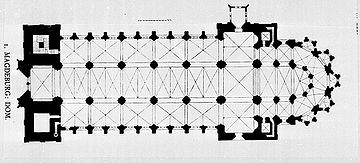
Gothic architecture
Gothic architecture is a style of architecture that flourished during the high and late medieval period. It evolved from Romanesque architecture and was succeeded by Renaissance architecture....
that had intrigued him in France. The French style was completely unknown in Germany, and the hired craftsmen only gradually mastered it.
The construction of the choir started in 1209, only two years after the fire that destroyed the previous church, but this choir is still in a very Romanesque
Romanesque architecture
Romanesque architecture is an architectural style of Medieval Europe characterised by semi-circular arches. There is no consensus for the beginning date of the Romanesque architecture, with proposals ranging from the 6th to the 10th century. It developed in the 12th century into the Gothic style,...
style, initially still using romanesque groin vault
Groin vault
A groin vault or groined vault is produced by the intersection at right angles of two barrel vaults. The word groin refers to the edge between the intersecting vaults; cf. ribbed vault. Sometimes the arches of groin vaults are pointed instead of round...
s, combined with a gothic center stone, which however is not needed for Romanesque groin vaults.
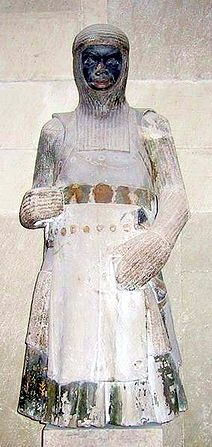
Construction stopped after 1274. In 1325, Archbishop Burchard III. von Schraplau was killed by the people of Magdeburg because of extreme tax
Tax
To tax is to impose a financial charge or other levy upon a taxpayer by a state or the functional equivalent of a state such that failure to pay is punishable by law. Taxes are also imposed by many subnational entities...
es. Folklore says that especially the beer tax increase caused much anger. Afterwards Magdeburg was under a ban
Ban (law)
A ban is, generally, any decree that prohibits something.Bans are formed for the prohibition of activities within a certain political territory. Some see this as a negative act and others see it as maintaining the "status quo"...
, and only after the donation of five atonement altars did the construction of the cathedral continue under Archbishop Otto von Hessen. Otto was also able to complete the interior construction, and formally opened the dome in 1363 in a week-long festival. At this time the cathedral was dedicated not only to St Maurice as before, but also to Saint Catherine
Catherine of Siena
Saint Catherine of Siena, T.O.S.D, was a tertiary of the Dominican Order, and a Scholastic philosopher and theologian. She also worked to bring the papacy of Gregory XI back to Rome from its displacement in France, and to establish peace among the Italian city-states. She was proclaimed a Doctor...
.
In 1360 the construction stopped again after the uncompleted parts have been covered provisionally. Only in 1477 did the construction start again under Archbishop Ernst von Sachsen, including the two towers. The towers were constructed by master builder Bastian Binder, the only master builder of the cathedral known by name. The construction of the cathedral was completed in 1520 with the placement of the ornamental cross on the north tower.
Luther, the Swedes, and Napoleon
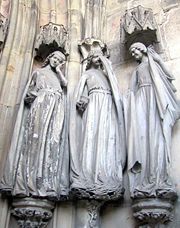
Martin Luther
Martin Luther was a German priest, professor of theology and iconic figure of the Protestant Reformation. He strongly disputed the claim that freedom from God's punishment for sin could be purchased with money. He confronted indulgence salesman Johann Tetzel with his Ninety-Five Theses in 1517...
published the 95 Theses
95 Theses
The Ninety-Five Theses on the Power and Efficacy of Indulgences , commonly known as , was written by Martin Luther, 1517 and is widely regarded as the primary catalyst for the Protestant Reformation...
in Wittenberg
Wittenberg
Wittenberg, officially Lutherstadt Wittenberg, is a city in Germany in the Bundesland Saxony-Anhalt, on the river Elbe. It has a population of about 50,000....
, Germany, which date is used as the start of the Protestant reformation
Protestant Reformation
The Protestant Reformation was a 16th-century split within Western Christianity initiated by Martin Luther, John Calvin and other early Protestants. The efforts of the self-described "reformers", who objected to the doctrines, rituals and ecclesiastical structure of the Roman Catholic Church, led...
. Luther also preached in Magdeburg in 1524. Some smaller churches in Magdeburg changed to Protestantism soon thereafter. The unpopularity of Archbishop Albrecht von Brandenburg also furthered the reformation, and after his death in 1545 in Mainz there was no successor. Magdeburg became a leader in the Protestant reformation, and was outlawed by the emperor. The Catholic church
Roman Catholic Church
The Catholic Church, also known as the Roman Catholic Church, is the world's largest Christian church, with over a billion members. Led by the Pope, it defines its mission as spreading the gospel of Jesus Christ, administering the sacraments and exercising charity...
stored the cathedral treasure in Aschaffenburg
Aschaffenburg
Aschaffenburg is a city in northwest Bavaria, Germany. The town of Aschaffenburg is not considered part of the district of Aschaffenburg, but is the administrative seat.Aschaffenburg is known as the Tor zum Spessart or "gate to the Spessart"...
for safekeeping, but the treasure was later lost to the Swedes
Sweden
Sweden , officially the Kingdom of Sweden , is a Nordic country on the Scandinavian Peninsula in Northern Europe. Sweden borders with Norway and Finland and is connected to Denmark by a bridge-tunnel across the Öresund....
in the Thirty Years' War
Thirty Years' War
The Thirty Years' War was fought primarily in what is now Germany, and at various points involved most countries in Europe. It was one of the most destructive conflicts in European history....
. The priests of the cathedral also changed to Protestantism, and on the first advent Sunday in 1567, the first Protestant worship service was held in the cathedral.

Sack of Magdeburg
The Sack of Magdeburg refers to the siege and subsequent plundering of the largely Protestant city of Magdeburg by the forces of the Holy Roman Empire and the Catholic League during the Thirty Years' War...
) by seeking refuge in the cathedral. The head priest, Reinhard Bakes, begged on his knees for the lives of his people before the conqueror Johan t'Serclaes, Count of Tilly
Johan t'Serclaes, Count of Tilly
Johann Tserclaes, Count of Tilly , commanded the Imperial forces in the Thirty Years' War. He had a string of important victories against the Protestants but was then defeated by forces led by the King Gustavus Adolphus of Sweden...
. The cathedral survived the fires in the city, and was dedicated again to the Catholic religion. However, as Tilly's catholic forces left Magdeburg, the cathedral was completely looted, and its colorful windows were shot out. Twenty thousand people of Magdeburg died during the war, and at the end of the war Magdeburg had a population of only 400. Magdeburg became part of Brandenburg
Brandenburg
Brandenburg is one of the sixteen federal-states of Germany. It lies in the east of the country and is one of the new federal states that were re-created in 1990 upon the reunification of the former West Germany and East Germany. The capital is Potsdam...
, and was transformed into a large fortress.
In 1806 Magdeburg was given to Napoleon
Napoleon I of France
Napoleon Bonaparte was a French military and political leader during the latter stages of the French Revolution.As Napoleon I, he was Emperor of the French from 1804 to 1815...
, and the cathedral was used for storage, and also as a horse barn
Barn
A barn is an agricultural building used for storage and as a covered workplace. It may sometimes be used to house livestock or to store farming vehicles and equipment...
and sheep pen. The occupation ended in 1814, and between 1826 and 1834 Frederick William III of Prussia
Frederick William III of Prussia
Frederick William III was king of Prussia from 1797 to 1840. He was in personal union the sovereign prince of the Principality of Neuchâtel .-Early life:...
financed the much-needed repairs and reconstruction of the cathedral. The glass windows were all replaced in 1900.
The 20th century

World War II
World War II, or the Second World War , was a global conflict lasting from 1939 to 1945, involving most of the world's nations—including all of the great powers—eventually forming two opposing military alliances: the Allies and the Axis...
completely destroyed the windows of the cathedral. During the heaviest firebombing
Firebombing
Firebombing is a bombing technique designed to damage a target, generally an urban area, through the use of fire, caused by incendiary devices, rather than from the blast effect of large bombs....
on January 16, 1945, one bomb hit the cathedral on the west side, destroying the wall, the organ
Organ (music)
The organ , is a keyboard instrument of one or more divisions, each played with its own keyboard operated either with the hands or with the feet. The organ is a relatively old musical instrument in the Western musical tradition, dating from the time of Ctesibius of Alexandria who is credited with...
, and some other parts of the building. Fortunately, the fire brigades were able to extinguish the flames on the roof structures in time, so damage to the cathedral was only moderate. The cathedral was opened again in 1955, and a new, smaller organ was installed at a different location in 1969.
With the establishment of the communist-led
Communist state
A communist state is a state with a form of government characterized by single-party rule or dominant-party rule of a communist party and a professed allegiance to a Leninist or Marxist-Leninist communist ideology as the guiding principle of the state...
German Democratic Republic in 1949, Magdeburg fell under Soviet
Soviet Union
The Soviet Union , officially the Union of Soviet Socialist Republics , was a constitutionally socialist state that existed in Eurasia between 1922 and 1991....
control. Communist leaders tried to suppress religion as a potential threat to communist doctrine, thus being active in church was a social disadvantage. The eradication of religion could not be accomplished, however, and weekly peace prayers were held in the cathedral beginning in 1983 in front of the Magdeburger Ehrenmal, a sculpture by Ernst Barlach
Ernst Barlach
Ernst Barlach was a German expressionist sculptor, printmaker and writer. Although he was a supporter of the war in the years leading to World War I, his participation in the war made him change his position, and he is mostly known for his sculptures protesting against the war...
. This led to the famous Monday demonstrations
Monday demonstrations in East Germany
The Monday demonstrations in East Germany in 1989 and 1990 were a series of peaceful political protests against the authoritarian communist government of the German Democratic Republic that took place every Monday evening.- Overview :...
of 1989 (similar to those in Leipzig
Leipzig
Leipzig Leipzig has always been a trade city, situated during the time of the Holy Roman Empire at the intersection of the Via Regia and Via Imperii, two important trade routes. At one time, Leipzig was one of the major European centres of learning and culture in fields such as music and publishing...
), which played a significant role in the German reunification
German reunification
German reunification was the process in 1990 in which the German Democratic Republic joined the Federal Republic of Germany , and when Berlin reunited into a single city, as provided by its then Grundgesetz constitution Article 23. The start of this process is commonly referred by Germans as die...
process.
The cathedral is currently undergoing a reconstruction phase that began in 1983 under the East German Government. In 1990, a number of solar cell
Solar cell
A solar cell is a solid state electrical device that converts the energy of light directly into electricity by the photovoltaic effect....
s were installed on the roof, marking the first solar cell installation on a church in East Germany. The solar cells provide energy for use in the church, with excess energy being added to the regional power network. The maximum output was 418 watt
Watt
The watt is a derived unit of power in the International System of Units , named after the Scottish engineer James Watt . The unit, defined as one joule per second, measures the rate of energy conversion.-Definition:...
s. In 2004, a funding drive started in 1997 for a new organ was completed, collecting €2.2 million. The new organ was built by the firm of Schuke Orgelbau (Werder an der Havel) near Potsdam
Potsdam
Potsdam is the capital city of the German federal state of Brandenburg and part of the Berlin/Brandenburg Metropolitan Region. It is situated on the River Havel, southwest of Berlin city centre....
and was completed in May 2008 and dedicated on Trinity Sunday, May 18th, 2008. Specs: ~36 tons, 93 registers and approximately 5500 pipes.
Barry Jordan of Port Elizabeth, South Africa was appointed as Organist
Organist
An organist is a musician who plays any type of organ. An organist may play solo organ works, play with an ensemble or orchestra, or accompany one or more singers or instrumental soloists...
and Choral director
Conducting
Conducting is the art of directing a musical performance by way of visible gestures. The primary duties of the conductor are to unify performers, set the tempo, execute clear preparations and beats, and to listen critically and shape the sound of the ensemble...
of the cathedral in August 1994.
The Magdeburger Ehrenmal (Monument) in the cathedral is once again the starting point of many Monday demonstrations, but this time the demonstrations are aimed against social reforms reducing government welfare. However, these demonstrations occur on a much smaller scale, so comparisons to the Monday demonstrations of 1989 are made mainly for publicity reasons.
Architecture

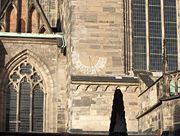
Sanctuary
A sanctuary is any place of safety. They may be categorized into human and non-human .- Religious sanctuary :A religious sanctuary can be a sacred place , or a consecrated area of a church or temple around its tabernacle or altar.- Sanctuary as a sacred place :#Sanctuary as a sacred place:#:In...
in the east
East
East is a noun, adjective, or adverb indicating direction or geography.East is one of the four cardinal directions or compass points. It is the opposite of west and is perpendicular to north and south.By convention, the right side of a map is east....
side of the church near the river Elbe
Elbe
The Elbe is one of the major rivers of Central Europe. It rises in the Krkonoše Mountains of the northwestern Czech Republic before traversing much of Bohemia , then Germany and flowing into the North Sea at Cuxhaven, 110 km northwest of Hamburg...
and ended with the top of the towers. This sanctuary shows a strong Romanesque architecture
Romanesque architecture
Romanesque architecture is an architectural style of Medieval Europe characterised by semi-circular arches. There is no consensus for the beginning date of the Romanesque architecture, with proposals ranging from the 6th to the 10th century. It developed in the 12th century into the Gothic style,...
influence. Unlike most other Gothic cathedrals, Magdeburg Cathedral does not have flying buttress
Flying buttress
A flying buttress is a specific form of buttressing most strongly associated with Gothic church architecture. The purpose of any buttress is to resist the lateral forces pushing a wall outwards by redirecting them to the ground...
es supporting the walls.
The building has an inside length of 120 meters, and a height to the ceiling of 32 meters. The towers rise to 99,25 and 100,98 meters, and are among the highest church towers in eastern Germany. The layout of the cathedral consists of one nave
Nave
In Romanesque and Gothic Christian abbey, cathedral basilica and church architecture, the nave is the central approach to the high altar, the main body of the church. "Nave" was probably suggested by the keel shape of its vaulting...
and two aisle
Aisle
An aisle is, in general, a space for walking with rows of seats on both sides or with rows of seats on one side and a wall on the other...
s, with one transept
Transept
For the periodical go to The Transept.A transept is a transverse section, of any building, which lies across the main body of the building. In Christian churches, a transept is an area set crosswise to the nave in a cruciform building in Romanesque and Gothic Christian church architecture...
crossing the nave and aisles. Each side of the transept has an entrance, the south entrance leading into the cloister. The ceiling in the nave is higher than in the aisles, allowing for clerestory
Clerestory
Clerestory is an architectural term that historically denoted an upper level of a Roman basilica or of the nave of a Romanesque or Gothic church, the walls of which rise above the rooflines of the lower aisles and are pierced with windows. In modern usage, clerestory refers to any high windows...
windows to give light to the nave. There is a separate narthex
Narthex
The narthex of a church is the entrance or lobby area, located at the end of the nave, at the far end from the church's main altar. Traditionally the narthex was a part of the church building, but was not considered part of the church proper...
(entrance area) in the west. The presbytery in the east is separated from the nave by a stone wall, serving the same function as a rood screen
Rood screen
The rood screen is a common feature in late medieval church architecture. It is typically an ornate partition between the chancel and nave, of more or less open tracery constructed of wood, stone, or wrought iron...
. The sanctuary and the apse
Apse
In architecture, the apse is a semicircular recess covered with a hemispherical vault or semi-dome...
follow the presbytery. The apse is also surrounded by an ambulatory
Ambulatory
The ambulatory is the covered passage around a cloister. The term is sometimes applied to the procession way around the east end of a cathedral or large church and behind the high altar....
. (See Cathedral diagram
Cathedral diagram
In Western ecclesiastical architecture, a cathedral diagram is a floor plan showing the sections of walls and piers, giving an idea of the profiles of their columns and ribbing. Light double lines in perimeter walls indicate glazed windows. Dashed lines show the ribs of the vaulting overhead...
for details on cathedral layouts) A secondary building around a large non-rectangular cloister
Cloister
A cloister is a rectangular open space surrounded by covered walks or open galleries, with open arcades on the inner side, running along the walls of buildings and forming a quadrangle or garth...
is connected to the south side of the cathedral. The cloister, whose south wall survived the fire of 1207 and is still from the original church, was parallel to the original church. Yet, the current church was constructed at a different angle, and hence the cloister is at an odd angle with the church.
The ground around the Elbe
Elbe
The Elbe is one of the major rivers of Central Europe. It rises in the Krkonoše Mountains of the northwestern Czech Republic before traversing much of Bohemia , then Germany and flowing into the North Sea at Cuxhaven, 110 km northwest of Hamburg...
river in Magdeburg is soft, and it is difficult to construct tall buildings, except for one large rock. Hence the cathedral was constructed on top of this rock, called Domfelsen in German, which means Cathedral Rock. At low water levels, this rock is visible in the Elbe. As in old times low water meant a small harvest, this rock is also called Hungerfelsen, meaning starvation rock. In any case, the rock was not big enough for the cathedral, and on the west end only the north tower could be placed on a solid rock foundation
Foundation (architecture)
A foundation is the lowest and supporting layer of a structure. Foundations are generally divided into two categories: shallow foundations and deep foundations.-Shallow foundations:...
, whereas the south tower stands on soft ground. To reduce weight the south tower is therefore only an empty shell with no interior or stairs, and the three big bell
Bell (instrument)
A bell is a simple sound-making device. The bell is a percussion instrument and an idiophone. Its form is usually a hollow, cup-shaped object, which resonates upon being struck...
s, "Susanne" (e), "Apostolica" (b) and "Dominica" (b), are in the north tower with a solid rock foundation. However, the south tower is slightly higher than the north tower, which is optically corrected by adding an ornamental cross on the north tower.
Art


Modern art
Modern art includes artistic works produced during the period extending roughly from the 1860s to the 1970s, and denotes the style and philosophy of the art produced during that era. The term is usually associated with art in which the traditions of the past have been thrown aside in a spirit of...
. The following list is not complete and only a summary of the most significant pieces. The list is roughly sorted by the time of creation.
- Antique pillarsColumnA column or pillar in architecture and structural engineering is a vertical structural element that transmits, through compression, the weight of the structure above to other structural elements below. For the purpose of wind or earthquake engineering, columns may be designed to resist lateral forces...
made from marbleMarbleMarble is a metamorphic rock composed of recrystallized carbonate minerals, most commonly calcite or dolomite.Geologists use the term "marble" to refer to metamorphosed limestone; however stonemasons use the term more broadly to encompass unmetamorphosed limestone.Marble is commonly used for...
, porphyryPorphyry (geology)Porphyry is a variety of igneous rock consisting of large-grained crystals, such as feldspar or quartz, dispersed in a fine-grained feldspathic matrix or groundmass. The larger crystals are called phenocrysts...
, and granite are used in the apse, originating from buildings in RavennaRavennaRavenna is the capital city of the Province of Ravenna in the Emilia-Romagna region of Italy and the second largest comune in Italy by land area, although, at , it is little more than half the size of the largest comune, Rome...
, transported to Magdeburg for the construction of the first building in 937 - The Baptismal fontBaptismal fontA baptismal font is an article of church furniture or a fixture used for the baptism of children and adults.-Aspersion and affusion fonts:...
made of rose porphyryPorphyry (geology)Porphyry is a variety of igneous rock consisting of large-grained crystals, such as feldspar or quartz, dispersed in a fine-grained feldspathic matrix or groundmass. The larger crystals are called phenocrysts...
from a site near Assuan, EgyptEgyptEgypt , officially the Arab Republic of Egypt, Arabic: , is a country mainly in North Africa, with the Sinai Peninsula forming a land bridge in Southwest Asia. Egypt is thus a transcontinental country, and a major power in Africa, the Mediterranean Basin, the Middle East and the Muslim world...
. Originally designed as a fountain with a hole in the center, the item may be thousands of years old, and is still used for baptism today. - The Grave of Otto I, Holy Roman Emperor from 973. During an exhumation in 1844 it was found that the grave contains a skeleton and some remains of clothes, but all offerings have been looted, presumably during the thirty year war. The Latin bronze inscription is made similar to historic designs.
- The sculpture of Saint MauriceSaint MauriceSaint Maurice was the leader of the legendary Roman Theban Legion in the 3rd century, and one of the favorite and most widely venerated saints of that group. He was the patron saint of several professions, locales, and kingdoms...
, created around 1250, is the first realistic depiction of an ethnic African in central European art, showing clearly the ethnic features as for example a broad nose. The figure is no longer complete. - The sculpture of Saint CatherineCatherine of SienaSaint Catherine of Siena, T.O.S.D, was a tertiary of the Dominican Order, and a Scholastic philosopher and theologian. She also worked to bring the papacy of Gregory XI back to Rome from its displacement in France, and to establish peace among the Italian city-states. She was proclaimed a Doctor...
, also around 1250, was created by the same artist as the sculpture of Maurice. - The Royal Couple (Herrscherpaar) in the sixteen-sided chapel (also around 1250) bear very realistic and lifelike expressions. The identity of the couple is unknown, but they may represent Emperor Otto I and his wife Edith, or JesusJesusJesus of Nazareth , commonly referred to as Jesus Christ or simply as Jesus or Christ, is the central figure of Christianity...
in heaven with his wife the holy church. - The sculptures of the five wise and the five foolish virgins (see The ten virgins from the List of Bible stories), also around 1250. This is the most remarkable piece of art in the cathedral. The five wise virgins are prepared and bring oil to a wedding, whereas the five foolish virgins are unprepared and bring no oil. Hence they have to go find oil and subsequently arrive late and cannot join the wedding anymore. The unknown artist masterfully expresses the emotions in the faces and the body languages of the girls, showing a much more realistic expression than what was common in art around that time. All figures are different, and have ethnic Slavic features. The sculptures are outside of the north entrance to the transept.
- The seats in the choir from 1363 are masterfully carved and show the life of Jesus. The unknown master also created the seats in the choir in Bremen's CathedralBremen CathedralBremen Cathedral , dedicated to St. Peter, is a church situated in the market square in the center of Bremen, in northern Germany. The cathedral belongs to the Bremian Evangelical Church, a member of the Protestant umbrella organisation named Evangelical Church in Germany...
. - The Magdeburger Ehrenmal by Ernst BarlachErnst BarlachErnst Barlach was a German expressionist sculptor, printmaker and writer. Although he was a supporter of the war in the years leading to World War I, his participation in the war made him change his position, and he is mostly known for his sculptures protesting against the war...
was ordered as a heroic war memorial, but due to his voluntary participation during World War I Barlach was against the war and showed the pain and suffering of the war instead. This created a great controversy, and the work was almost destroyed. The spot in front of this sculpture was also the starting point of the Monday demonstrations. - The Lebensbaumkruzifix (literally: Tree of life cross) is a painted bronze sculpture from 1986 and expanded in 1988 that shows Jesus nailed to a tree instead of a cross. Jesus is attached to the tree only with his hands and feet, and is otherwise hanging freely. The sculpture was designed not only to be viewed from the front but from all sides. The tree is barren except for a small leaf of hope/life where the blood of Jesus drips on the tree. The artist, Prof. Jürgen Weber, wanted the sculpture to be the centerpiece near the altar, but the sculpture was placed on the south side of the transept against his wishes.
Sources
- Nicola Coldstream (2002) "Medieval Architecture", Oxford History of Art, Oxford University Press, ISBN 0-19-284276-5.
- "Der Dom zu Magdeburg", DKV Kunstführer Nr. 415/2, Munich.
- Buchholz, Ingelore (2001): Magdeburg: Der Stadtführer, Verlag Janos Stekovics, ISBN 3-932863-84-4.
- Sussman, Michael (1997): Der Dom zu Magdeburg, Passau.
- Ullmann, Ernst (1989): Der Magdeburger Dom: ottonische Gründung und staufischer Neubau, Leipzig
External links
- Magdeburg Cathedral from the official homepage of Magdeburg
- Magdeburg Cathedral by Andrew Love
- Der Magdeburger Dom (German)
- Kirchen und Klöster zu Magdeburg (German)
- City of Magdeburg Tourist Information

